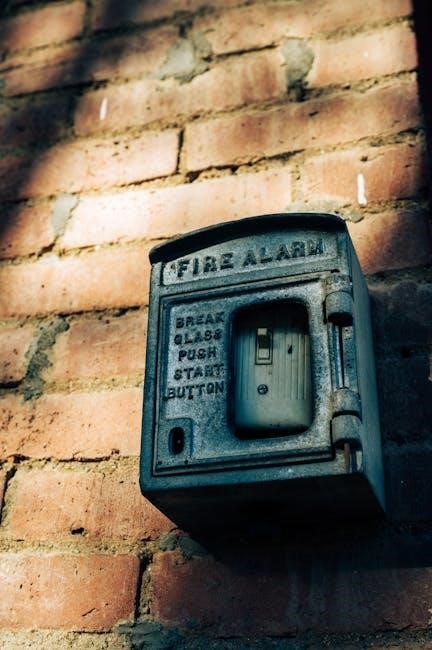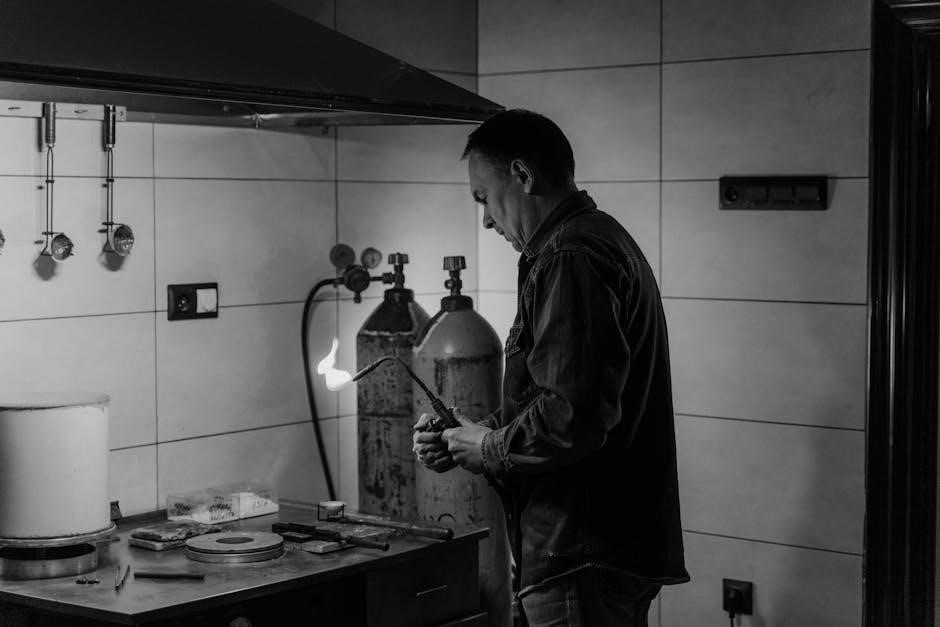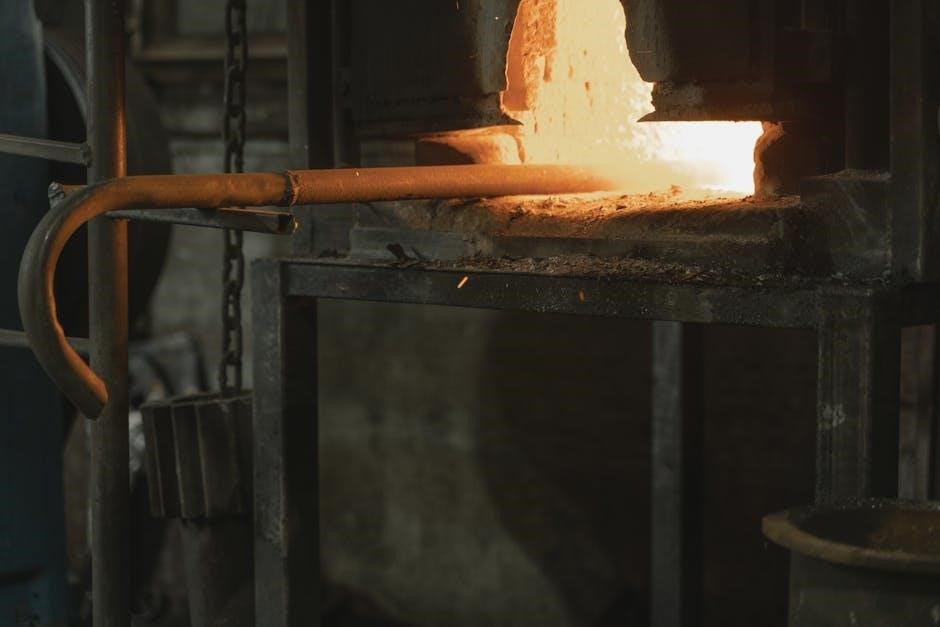
Firex Fire Alarm Manual: A Comprehensive Guide
Welcome to the ultimate resource for your Firex fire alarm system. This guide offers comprehensive insights, from model specifics to troubleshooting. Ensure optimal safety with clear instructions on installation, maintenance, and understanding alarm signals. We aim to empower you with knowledge.
Firex fire alarms are essential components of any home or building’s safety system, designed to provide early warning in the event of a fire. This section introduces you to the world of Firex alarms, outlining their importance and role in fire prevention. Understanding the basics of these devices is crucial for ensuring the safety of yourself, your loved ones, and your property.
Firex is a well-known brand in the realm of fire safety, offering a variety of smoke and carbon monoxide detectors; These alarms are designed to meet specific safety standards and regulations, providing reliable protection against fire hazards. Their primary function is to detect smoke or carbon monoxide and emit a loud alarm, alerting occupants to evacuate the premises quickly.
This introduction will cover the fundamental aspects of Firex fire alarms, including their types, key features, and the importance of proper installation and maintenance. By familiarizing yourself with these basics, you can make informed decisions about selecting and using Firex alarms to safeguard your home or business. Remember that regular testing and upkeep are crucial for ensuring they function effectively when needed most.
Understanding Firex Smoke Alarm Models
Firex offers a diverse range of smoke alarm models, each designed with specific features and technologies to cater to different needs and environments. This section provides an overview of some popular Firex smoke alarm models, highlighting their key characteristics and functionalities. Knowing the distinctions between these models is essential for selecting the most suitable option for your home or business.
One common type is the ionization smoke alarm, known for its ability to quickly detect fast-flaming fires. Another type is the photoelectric smoke alarm, which is more sensitive to slow-smoldering fires. Some Firex models combine both ionization and photoelectric sensors for comprehensive fire detection.

Specific models like the Kidde Firex i4618 are AC/DC powered and utilize ionization sensing technology. Others, such as the FADC model, operate on a 120V AC power source with a 9V battery backup. Each model has its own user manual, providing detailed instructions on installation, operation, and maintenance. Understanding these nuances ensures optimal performance and safety.
Consider factors such as power source, sensor type, and additional features like hush buttons and interconnectivity when choosing the right Firex smoke alarm for your needs.
Key Features and Technologies
Firex smoke alarms incorporate several key features and technologies designed to enhance their performance and reliability. These features ensure that the alarms provide timely and accurate warnings in the event of a fire. Understanding these technologies helps users appreciate the capabilities of their Firex alarms and maintain them effectively.
One prominent technology is ionization sensing, which is particularly effective at detecting fast-flaming fires. Firex alarms also utilize photoelectric sensing technology, which is better suited for detecting slow-smoldering fires. Some models combine both sensing technologies for comprehensive protection against various types of fires.
Many Firex alarms feature battery backup, ensuring continuous operation even during power outages. LED indicators provide visual confirmation of power status and alarm conditions. Hush buttons allow users to temporarily silence nuisance alarms caused by cooking or steam.
Select models offer interconnectivity, allowing multiple alarms to communicate with each other. When one alarm detects smoke, all interconnected alarms will sound, providing early warning throughout the premises. These key features and technologies contribute to the overall effectiveness and reliability of Firex smoke alarms, making them a crucial component of any fire safety plan. Regular testing and maintenance are essential to ensure these features function as intended.
Installation Guide for Firex Alarms
Proper installation is crucial for the effective operation of your Firex alarm. Before you begin, carefully review the safety precautions and limitations outlined in the manual. Ensure you have all the necessary tools and materials, including screws, a drill, and a screwdriver. Select appropriate locations for your alarms, following guidelines for placement on ceilings or walls.
For hardwired alarms, turn off the power at the circuit breaker before starting. Connect the alarm’s wiring to the house wiring, matching the colors correctly. Secure the alarm to the mounting bracket and attach it to the ceiling or wall. If your alarm has a battery backup, insert the battery according to the instructions.
For battery-powered alarms, simply attach the mounting bracket to the ceiling or wall and secure the alarm to the bracket. After installation, test the alarm by pressing the test button. Ensure the alarm sounds loudly and clearly. If you are installing multiple interconnected alarms, follow the instructions for linking them together.
After installation, it is important to regularly test and maintain your Firex alarms to ensure they are functioning correctly. Proper installation and regular maintenance will maximize the effectiveness of your alarms and help protect your home and family.
Operating Instructions
Operating your Firex alarm is straightforward. Once installed, the alarm continuously monitors for smoke or carbon monoxide, depending on the model. In standby mode, a green LED light usually indicates that AC power is connected, while a blinking red LED light signifies normal operation. Familiarize yourself with these indicators.
When smoke or carbon monoxide is detected, the alarm will sound a loud, distinctive alert. It’s crucial to know the difference between alarm signals. Some models feature a hush button that temporarily silences nuisance alarms, such as those caused by cooking smoke. Refer to your specific model’s manual for the duration of the hush period.
Regularly test your alarm by pressing the test button. This confirms the alarm’s functionality and ensures the sounder is working. If the alarm fails to sound during the test, check the power source and battery. Replace the battery immediately if it’s low or expired. Also, know how to reset your alarm after a triggered event.
Understanding these operating instructions ensures your Firex alarm provides reliable protection. Always consult your user manual for complete details and safety information related to your specific model.
Maintenance and Testing Procedures
Regular maintenance and testing are crucial for ensuring your Firex alarm’s reliability. A simple monthly test can confirm its functionality. Press and hold the test button until the alarm sounds. If it doesn’t, investigate the power source and battery. For hardwired alarms, ensure the AC power is on and the backup battery is correctly installed.
Dust and debris can accumulate, affecting the alarm’s sensitivity. Clean the alarm every six months using a vacuum cleaner with a brush attachment. Gently vacuum the exterior to remove any buildup. Avoid using water or cleaning solutions, as they can damage the sensors.
Battery replacement is a vital part of maintenance. Replace batteries at least once a year, or immediately when the low-battery indicator chirps. Some alarms have a 9V battery backup, while others use different types. Check your manual for specific battery requirements.
Keep a record of your maintenance and testing activities. This helps track battery replacement dates and identify potential issues early on. By following these procedures, you can extend the lifespan of your Firex alarm and maintain a safe environment. Remember, consistent care ensures consistent protection.
Troubleshooting Common Issues
Encountering issues with your Firex alarm? Let’s address some frequent problems. A persistent chirping usually indicates a low battery. Replace it immediately with the correct type specified in your manual. False alarms can occur due to dust, steam, or cooking fumes. Ensure alarms are away from kitchens and bathrooms, and clean them regularly.
If the alarm doesn’t sound during testing, check the power source. For hardwired alarms, confirm the circuit breaker hasn’t tripped. Ensure the backup battery is correctly installed and functioning. If problems persist, consider replacing the alarm, especially if it’s nearing its expiration date.
Inconsistent or intermittent alarms may signal a sensor malfunction. Try cleaning the alarm thoroughly. If the issue continues, professional inspection or replacement is recommended. Never disable the alarm to stop nuisance alerts; this compromises safety.
Compatibility issues can arise when integrating different alarm types. Ensure all alarms in your system are compatible and follow the manufacturer’s guidelines for interconnected systems. By systematically addressing these common issues, you can maintain a reliable and effective fire safety system. Remember, safety first!
Battery Replacement Guidelines
Maintaining functional Firex alarms necessitates diligent battery replacement. Typically, a low-battery chirp indicates the need for a new battery. Use only the recommended battery type specified in your Firex alarm manual to ensure optimal performance. Before replacing, disconnect the alarm from AC power if applicable.
When replacing the battery, carefully remove the old one and dispose of it properly following local regulations. Install the new battery, ensuring correct polarity. After replacement, test the alarm by pressing the test button. A loud, clear sound confirms proper operation. If the alarm fails to sound, recheck battery installation.
It’s advisable to replace batteries annually, even if the low-battery signal hasn’t activated. Consider using long-life batteries for extended reliability. Document the replacement date on the alarm for easy tracking. Regularly testing after battery changes guarantees ongoing protection.
Never use rechargeable batteries, as they may not provide consistent voltage. Always have spare batteries on hand to prevent downtime. Following these battery replacement guidelines will keep your Firex alarms functioning effectively, safeguarding your home and family from potential fire hazards.
Understanding Alarm Signals
Firex alarms communicate crucial information through distinct audible and visual signals. A continuous, loud alarm typically signifies the detection of smoke or carbon monoxide, demanding immediate evacuation. Familiarize yourself with your alarm’s specific sound pattern and response protocols outlined in the user manual.
Intermittent chirping often indicates a low battery, prompting immediate replacement. Some models utilize different chirp patterns to distinguish between low battery and other malfunctions. Red LED lights flashing in standby mode show the AC power is connected. Rapid blinking accompanies alarm activation.
Understanding these signals empowers swift, appropriate action. A persistent alarm necessitates evacuation and contacting emergency services. Low-battery chirps require prompt battery replacement. False alarms may occur due to steam or cooking smoke, requiring ventilation and resetting the alarm.
Regularly test your alarms to ensure proper signaling functionality. This proactive approach helps familiarize household members with alarm sounds, improving response effectiveness during emergencies. Refer to your Firex manual for detailed signal descriptions and recommended actions, maximizing safety and minimizing potential hazards.
Safety Precautions and Limitations
Firex alarms provide crucial early warnings, but they aren’t foolproof and shouldn’t replace comprehensive safety measures. Smoke alarms are not a substitute for insurance, and consistent fire prevention practices are your best safeguard. Regularly inspect and maintain your alarms according to the manual’s instructions.
Never disconnect or disable alarms, even during cooking or other activities that may cause nuisance alarms; instead, ventilate the area. Understand the limitations of ionization and photoelectric sensors; ionization alarms excel at detecting fast-flaming fires, while photoelectric alarms are more sensitive to smoldering fires. Ideally, use both types or combination alarms.

Smoke alarms are designed to minimize false alarms, but cigarette smoke blown directly into the alarm may activate it. Replace alarms within their specified lifespan, typically 5 to 10 years; Hardwired alarms require professional installation, while battery-powered alarms demand routine battery checks and replacements.
Consult the user manual for specific safety guidelines related to your Firex model. Smoke alarms may not be effective in situations where individuals are impaired or unable to hear the alarm. Develop and practice a family escape plan to ensure a swift and safe evacuation during a fire emergency.
Firex Alarm Compatibility and Integration
Firex alarms are designed for standalone operation but can often be integrated into broader home safety systems. Compatibility varies between models, so consult your specific Firex alarm manual for detailed information.
Some Firex alarms can be interconnected, meaning that when one alarm detects smoke, all interconnected alarms will sound, providing earlier warning throughout the house. Ensure that interconnected alarms are of the same brand and model to guarantee proper functioning. Do not connect Firex alarms to other types of smoke alarms or auxiliary devices unless explicitly approved in the manual.
Certain Firex models are compatible with smart home systems like Google Home and Alexa, allowing for voice control and remote monitoring of alarm status. Check your alarm’s specifications to confirm smart home integration capabilities. Proper installation and configuration are essential for seamless integration with existing systems.

When replacing older alarms, ensure that the new Firex alarms are compatible with your home’s wiring and mounting infrastructure. If you’re unsure about compatibility, consult a qualified electrician. Consider using combination smoke and carbon monoxide detectors for comprehensive protection against both fire and carbon monoxide hazards. Regularly test integrated systems to verify that all components are functioning correctly.
Disposal and Recycling Information
Proper disposal of your old Firex alarm is essential for environmental responsibility and safety. Smoke alarms contain electronic components and, in some cases, small amounts of radioactive material in the ionization chamber. Therefore, it’s crucial to avoid simply throwing them in the trash.
Before disposal, remove the battery from the Firex alarm. Check your local regulations for battery recycling programs, as batteries often contain hazardous materials like lithium or alkaline compounds. Many communities offer designated drop-off locations or collection events for used batteries.

For the alarm unit itself, contact your local waste management authority or recycling center to inquire about electronic waste (e-waste) recycling programs. Some municipalities have specific guidelines for disposing of smoke detectors due to the presence of radioactive materials.
If your local area doesn’t offer e-waste recycling for smoke alarms, consider contacting the manufacturer, Firex, directly. They may have take-back programs or specific recommendations for responsible disposal. Alternatively, some retailers that sell smoke alarms may also offer recycling services for old units.
By following these disposal and recycling guidelines, you can minimize the environmental impact of your old Firex alarm and ensure that it is handled in a safe and responsible manner.